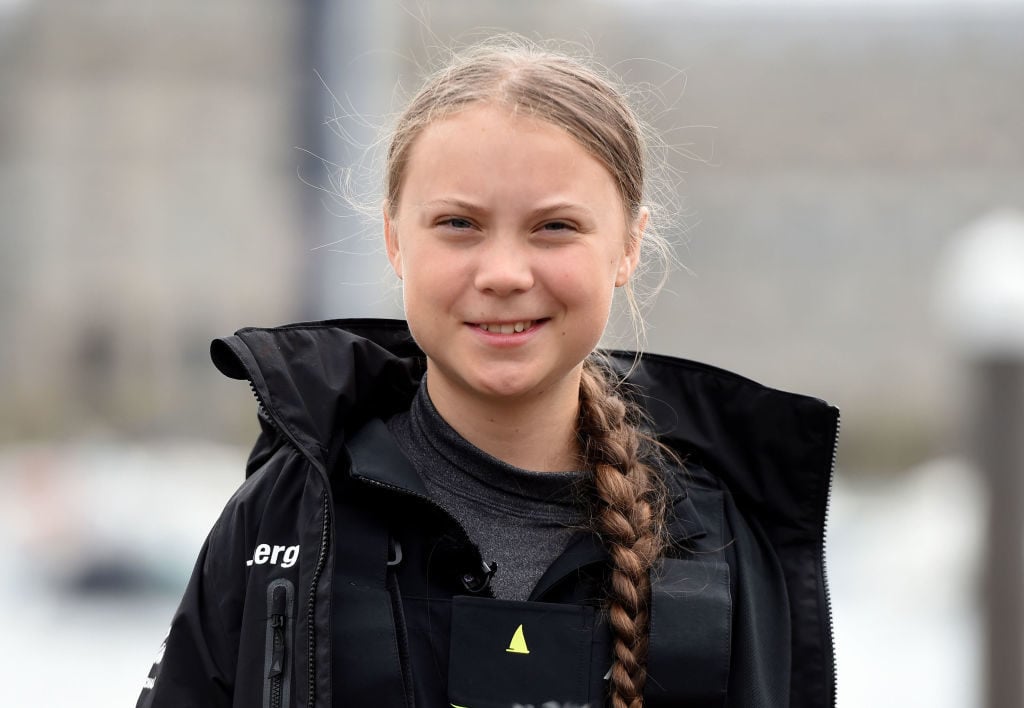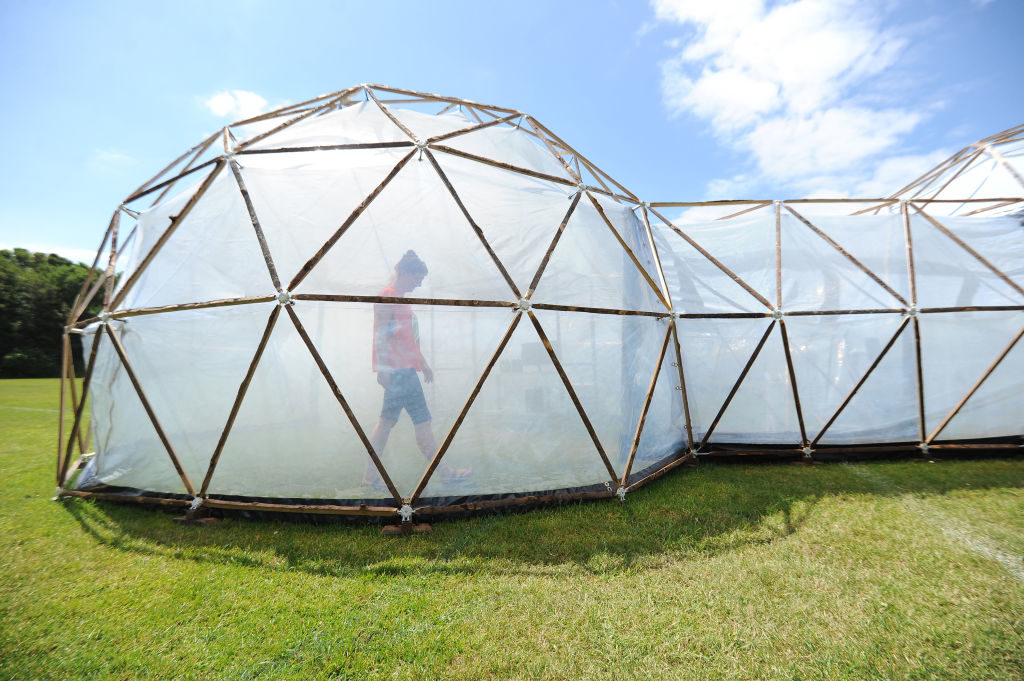People
How Teen Climate Activist Greta Thunberg Inspired the Art World to Address the Biggest Problem Facing Humanity
The 16-year-old’s message is inspiring artists and curators to respond to the mounting climate emergency.

The 16-year-old’s message is inspiring artists and curators to respond to the mounting climate emergency.

Naomi Rea

Later this month, the 16-year-old Swedish climate activist Greta Thunberg will visit the UN’s Climate Action Summit in New York. As part of the convention, she has been invited to visit the British artist Michael Pinsky’s work, Pollution Pods, which will be installed in front of the UN building and presents six interconnected, climatically controlled chambers that mimic the relative air quality in cities around the world, from London to Beijing.
Since the teenage activist began a humble school strike for the climate a year ago, she has quickly become a household name—and an inspiration for many in the art world. Her message—that we need systemic action to protect our environmental future—has gained enough momentum to earn itself a name: the “Greta Thunberg Effect.”
In the culture world, she has inspired installations like Pinsky’s; portraits by the painter Elizabeth Peyton and the photographer Hellen van Meene; a mural by the street artist Jody Thomas; a multimedia work by Justin Brice Guariglia; and an exhibition by the curator Francesca Pietropaolo.
“What is remarkable about Greta is that she suddenly became a huge presence slightly over a year ago and now it seems like she has been there forever,” Pinsky tells artnet News.
While youth movements have a long history—Pinsky remembers protesting an exhibition that promoted nuclear power at the National Museum of Scotland when he was 11 years old—something about Thunberg has managed to capture the zeitgeist in an unprecedented way.

Michael Pinsky’s Pollution Pods. Photo by Finnbarr Webster/Getty Images.
Given Thunberg’s clear resonance, it is no surprise that she has inspired not only artists, but also curators.
At this year’s Venice Biennale, where climate change is a major theme, the Italian curator Francesca Pietropaolo co-organized a show that explores the issue with artist and curator Phong Bui. And Pietropaolo, perhaps unsurprisingly, cites Thunberg, who declined to be interviewed for this article, as an influence.
“Greta is an inspiring member of the new generation,” Pietropaolo tells artnet News. “Her voice has become an important catalyst for change.” Pietropaolo is particularly interested in the positive tone of Thunberg’s activism, which is in contrast to the apocalyptic, spectacular tone of so many others.
“I think that Greta’s activism could also inspire a reflection, from a curatorial perspective, on the making of contemporary art exhibitions, taking into consideration their very process in order to evaluate their environmental impact,” Pietropaolo says. Curators could be inspired, for example, to study and reflect upon the environmental footprint they leave when they do their work. “I think of Venice in particular, with its fragile reality.”
The practical impact of Thunberg’s voice is not limited to Pietropaolo. The Dutch photographer Hellen van Meene, who shot Thunberg for the cover of TIME magazine, tells artnet News that after they met, she decided to travel to London and Berlin via train for a later work trip, rather than to take an emission-heavy airplane.
“There has been a palpable change of mood in the arts sector, with a real sense of urgency and a desire for action being driven by artists and the wider public,” the director of Tate Modern, Frances Morris, tells artnet News.
The directors of the Tate galleries recently declared a climate emergency and laid out a plan to improve the institution’s commitment to sustainability, aiming to reduce its carbon footprint by 10 percent within four years.
“An emergency of this magnitude can easily feel overwhelming, so the voices of people like Greta Thunberg have an important role to play,” Morris explains. “They help provide focus and inspiration, particularly for a younger generation whose lives will be profoundly shaped by this crisis.”
Similarly, the curator Lucia Pietroiusti, who organized the prize-winning Lithuanian pavilion in Venice, has introduced a General Ecology project at the Serpentine Galleries in London, which has committed to reducing its carbon footprint. In 2020, it will be dedicating its entire 50th anniversary year to ecological concerns.
At the same time, Thunberg and others have called upon institutions to break their partnerships with fuel companies such as BP. While Tate Modern ended a years-long partnership with the oil giant BP in 2017, others have been slower to make the transition, and Thunberg’s voice is amplifying the pressure.
“… I do not wish to be associated with BP any more than I would with an arms dealer, a tobacco salesmen or any company or individual who willfully destroys the lives of others alive and unborn.”
This is what a role model looks like in 2019. https://t.co/Ts4x51Skdg
— Greta Thunberg (@GretaThunberg) June 26, 2019
The codirector of the activist group Culture Unstained, Chris Garrard, tells artnet News that even through a tweet, Thunberg has played a powerful role.
“In just the past few weeks, the directors of the British Museum, the National Portrait Gallery, and the Science Museum have endorsed BP and Big Oil,” he says. “The impact of Greta’s activism has been that their oil sponsorship deals now look out of date and out of step with the wider sector, and will only do damage to their reputations.”
Images of the young Swedish woman, meanwhile, have become a stand-in for her message.
Last spring, Peyton presented a picture of Thunberg at Sadie Coles HQ in London. But the visibility of that work paled in comparison to a massive, 50-foot mural of Thunberg made in Bristol that depicts her submerged in rising floods, with the waterline raised high enough to sabotage her most powerful weapon: her mouth.
“When someone gives you a wall, they’re giving you a stage, an opportunity to step up and make an impact,” the street artist who created the mural, Jody Thomas, tells artnet News. When he landed on the idea of painting the young climate activist, Thomas says “it just felt right.” He says his proposal for the wall received the fastest approval of any mural project he has ever done.
His image soon went viral, even making it as far as Thunberg’s own Instagram page, where the activist adopted it as her profile picture. “The fact that the piece went global is testament to the fact that street artists and artists can play a role in visualizing a tricky and contentious issue at the moment that is very much on the minds of everyone,” Thomas says.
Thunberg’s words have also served as fodder for artists. The US artist Justin Brice Guariglia included sections of a speech she delivered at the World Economic Forum in a courtyard installation presented at London’s Somerset House in the spring. The work, Reduce Speed Now!, was made of nine solar-powered highway message boards, which presented texts about climate change from Thunberg, Bruno Latour, Zadie Smith, and other philosophers, anthropologists, and poets.
“When Greta came along, she was like a breath of fresh air,” Guariglia tells artnet news. “Here was this young woman who was essentially like the Lorax,” he says, referring to the Dr. Seuss character who speaks on behalf of trees. “She is speaking up for the next generation, the people that don’t have a voice.”
Guariglia says that although he has been making art about climate change for the past decade, it takes an “exceptionally good communicator” like Thunberg to really convey the urgency of the problem.
“When I think about my work, especially when I’m working with text, I’m thinking in that same mode,” Guariglia says. “How can I be really pithy? How do you communicate that we’re heading towards 100 million-plus climate crisis refugees? How do you communicate these ideas in ways that the general public would actually be concerned?”
In Guariglia’s eyes, Thunberg successfully gives people new language with which to discuss these “very important, very urgent, very existential” issues.